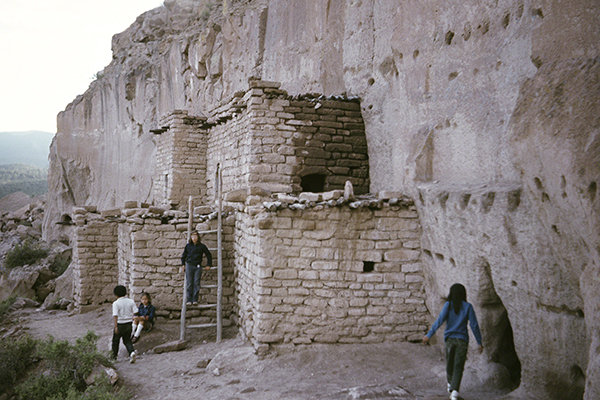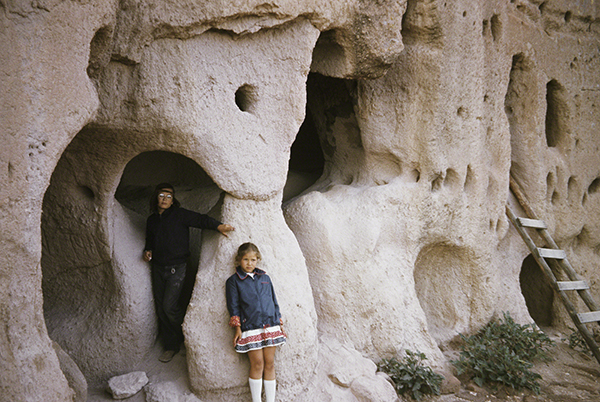Native American Heritage: The Anasazi
In celebration of Native American Heritage Month, let’s take a look at one of the many cultures that occupied regions of the United States before European settlement: the Anasazi. Scholars now believe that Native Americans migrated from Asia via the land bridge in the Bering Strait as many as 12,000 to 25,000 years ago. That’s waaaaaay before European settlement and something to be celebrated!
 |
| Anasazi Culture, Puye Cliff Dwellings, entrance chambers of adobe, Española, New Mexico, 1100s–ca. 1580s. Image © 2023 Davis Art Images. (8S-11501) |
The Puye Cliff Dwellings are on the Pajarito Plateau in the Jemez Mountains in northern central New Mexico. They are thought to have been the winter dwellings of the Anasazi, who hunted and farmed there from around the 1100s to the 1570s CE. The Anasazi were a predecessor of Pueblo communal architecture, and the ancestors of the Pueblo culture at Santa Clara Pueblo near Puye.
Dwellings at Puye include two main levels carved into the cliffs and caves, a multistory complex on top of the mesa, and fieldstone-constructed structures at the base. The first level of carved dwellings is more than one mile (1.6 kilometers) long along the base of the mesa, while the second level is about 2100 feet long (640 meters). “Halls” and stairways were carved out of the rock, connecting the two levels and providing access to the top of the mesa. The multistory complex on top of the mesa was centered around a plaza. These multistoried structures at Puye are much like the construction of Taos Pueblo, built between 1000 and 1450 CE with continuous settlement to the present day.
 |
| Anasazi Culture, Puye Cliff Dwellings, entrance carved out of the tufa cliffs, Española, New Mexico, 1100s–ca. 1580s. Image © 2023 Davis Art Images. (8S-11502) |
Formed from volcanic eruptions in the Jemez Mountains, the Pajarito Plateau—out of which the Puye Cliff Dwellings were carved—consists of basalt and volcanic tufa (also called tuff or travertine). Erosion from natural forces created cliffs along the mountain canyons. The Anasazi carved the soft tufa into living spaces using stone tools.
Evidence of the history of the Anasazi culture exists in the region of the Four Corners, where the borders of Utah, Colorado, Arizona, and New Mexico meet. The Anasazi are believed to have begun farming around 100 BCE. Various types of domesticated plants from Mexico such as corn, squash, and beans had been introduced around 200 BCE.
The Anasazi were dry farmers who relied on unpredictable rainfall for growing crops. With advancements in more reliable farming techniques, the Anasazi became sedentary town dwellers by approximately 500 CE. Archaeological evidence from sites in Chaco Canyon indicates that Anasazi groups foraged the open grasslands during most of the year and returned to sheltered canyon dwellings during the winters.
Roads and platforms from which signals could be sent to neighboring groups point to how organized Anasazi communities were. They also had an extensive trade network that reached Mexico and the eastern Plains—Anasazi pottery fragments have been found as far east as Ohio. By far the most significant achievement of the Anasazi was their use of stone and adobe construction to build large communal, aboveground dwellings, predecessors of the pueblo. The cliff dwellings at Mesa Verde are some of the most spectacular examples of ancient North American stone construction.
The original permanent architecture used by the Anasazi was a semi-subterranean structure called a pit house. Key features were supporting wooden posts, an entrance hole in the roof, and supporting walls of adobe and mud plaster. After 900 CE, the circular form of the pit house, combined with rectangular rooms, became the basis for the most ambitious building projects in aboriginal North America.
Correlations to Davis programs: Explorations in Art 2E Grade 4: 3.5, 3.8; Explorations in Art 2E Grade 5: 2.8; Explorations in Art 2E Grade 6: 4.1, 4.2; A Community Connection 2E: 1.4; A Global Pursuit 2E: 8.4


Comments